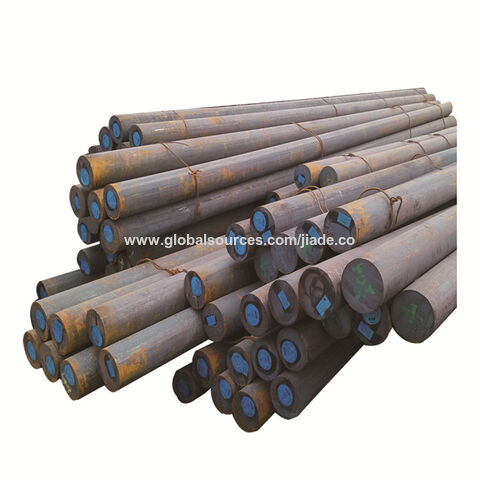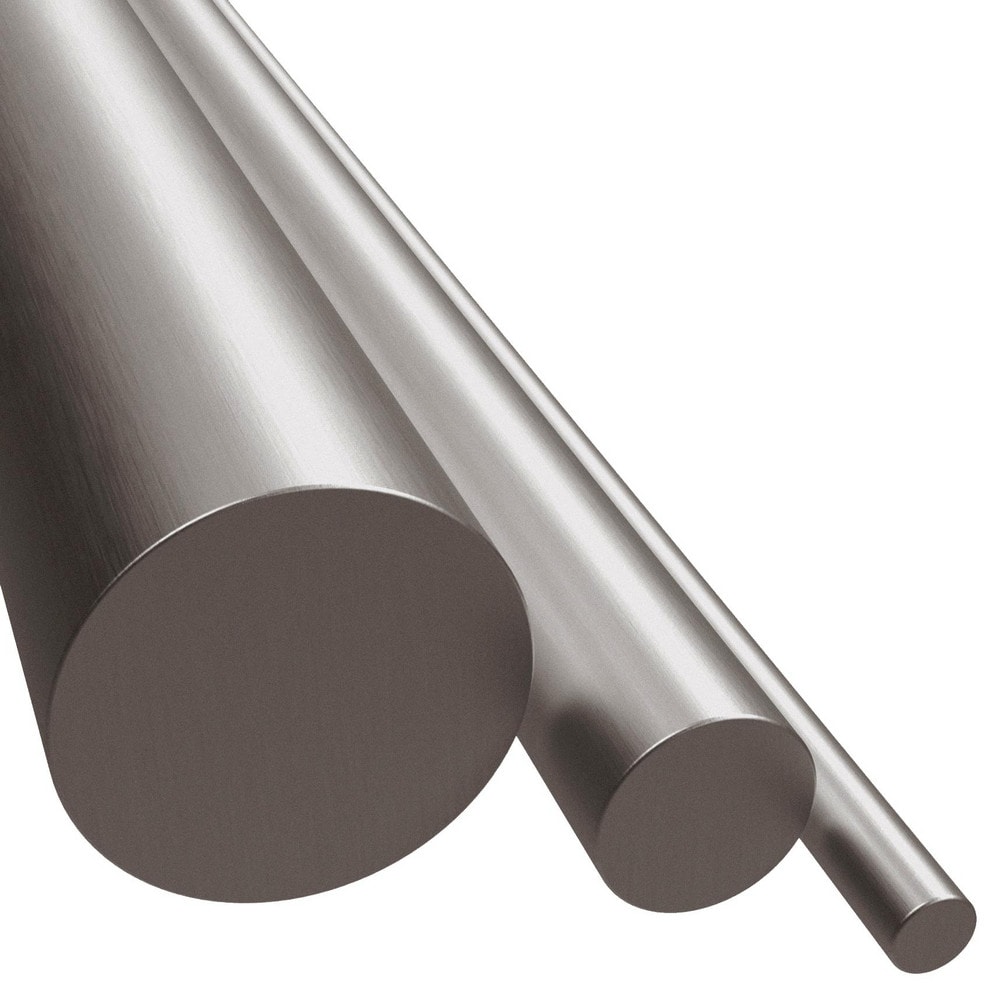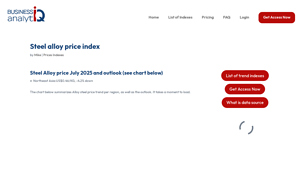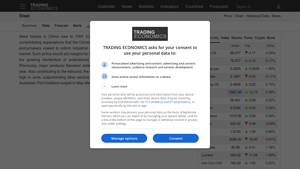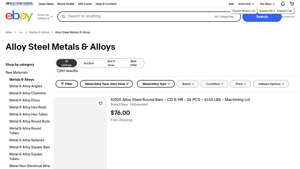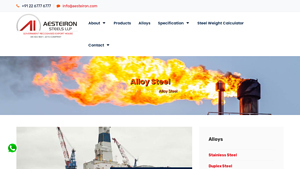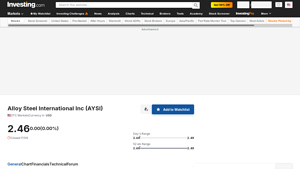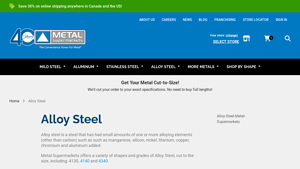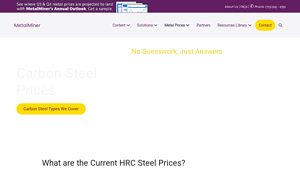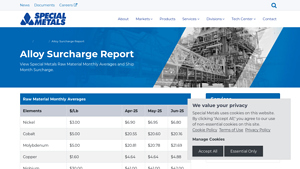Alloy Steel Price Guide: Type, Cost, Top List…
Introduction: Navigating the Global Market for alloy steel price
Navigating the global market for alloy steel prices can be a daunting task for B2B buyers, particularly in regions like Africa, South America, the Middle East, and Europe. The fluctuating costs of alloy steel, influenced by supply and demand dynamics, regional market trends, and the specific grades of steel, present a significant challenge. This guide aims to demystify the complexities of alloy steel pricing, offering a comprehensive overview that includes various types of alloy steels, their applications across industries, and effective strategies for supplier vetting.
Understanding the nuances of alloy steel pricing is crucial for making informed purchasing decisions. This guide will equip you with insights into the different grades of alloy steel, such as 4130, 4140, and 4340, along with their specific applications in automotive, aerospace, and industrial sectors. We will also delve into practical advice on sourcing, including how to navigate price fluctuations and the importance of considering quality certifications when selecting suppliers.
By leveraging the information provided in this guide, international B2B buyers can enhance their procurement strategies, ensuring they secure the best prices while maintaining high standards of quality and performance. Whether you’re operating in the bustling markets of Nigeria or the industrial hubs of Saudi Arabia, this resource is designed to empower you with the knowledge needed to thrive in the competitive landscape of alloy steel procurement.
Understanding alloy steel price Types and Variations
| Type Name | Key Distinguishing Features | Primary B2B Applications | Brief Pros & Cons for Buyers |
|---|---|---|---|
| 4130 Alloy | Malleable, heat-treated, contains chromium | Aerospace, automotive, manufacturing | Pros: Good weldability, versatile; Cons: May require specific heat treatment. |
| 4140 Alloy | High strength, less malleable, contains molybdenum | Heavy machinery, automotive parts | Pros: Excellent toughness, fatigue resistance; Cons: Higher cost compared to carbon steel. |
| 4340 Alloy | High fatigue resistance, retains strength post-bend | Aerospace, hydraulic components | Pros: Superior strength and durability; Cons: More expensive, requires precise fabrication. |
| 8620 Alloy | Low alloy steel with nickel and chromium, good hardenability | Gears, shafts, automotive applications | Pros: Good wear resistance; Cons: More complex heat treatment needed. |
| AR500 Steel | Abrasion-resistant, high hardness, suitable for wear applications | Mining, construction, military | Pros: Outstanding wear resistance; Cons: Limited ductility, not suitable for all applications. |
What Are the Characteristics of 4130 Alloy Steel?
4130 alloy steel is known for its malleability and ability to undergo heat treatment, making it a popular choice in industries such as aerospace and automotive manufacturing. Its chromium content enhances its strength and resistance to wear, while its versatility allows it to be used in various applications, from roll cages to gears. When purchasing 4130 steel, buyers should consider the specific heat treatment required for their application, as this can affect the material’s performance and cost.
How Does 4140 Alloy Steel Stand Out?
4140 alloy steel is characterized by its high strength and toughness, making it ideal for heavy-duty applications like machinery and automotive parts. The presence of molybdenum enhances its hardenability, allowing it to withstand significant stress and fatigue. Buyers should weigh the benefits of its excellent mechanical properties against the higher cost compared to carbon steel, ensuring that the investment aligns with the expected performance requirements.
Why Choose 4340 Alloy Steel for Aerospace Applications?
4340 alloy steel is distinguished by its high fatigue resistance and the ability to retain strength even after bending. This makes it particularly suitable for aerospace and hydraulic components where reliability is critical. When considering 4340 steel, B2B buyers should evaluate the precision required in fabrication and the associated costs, as its superior properties often come at a premium.
What Are the Advantages of Using 8620 Alloy Steel?
8620 alloy steel is a low-alloy steel that incorporates nickel and chromium, providing good hardenability and wear resistance. It is commonly used in the manufacturing of gears and shafts in automotive applications. Buyers should consider the complexity of heat treatment processes needed to optimize its properties, as this can influence both the price and the final performance of the components.
When Should You Use AR500 Steel?
AR500 steel is specifically designed for high abrasion resistance, making it ideal for applications in mining, construction, and military contexts. Its high hardness level ensures outstanding wear resistance, but buyers must be aware that its limited ductility may restrict its use in certain applications. Understanding the specific demands of the intended use is crucial when selecting AR500, as it can significantly impact operational efficiency and costs.
Key Industrial Applications of alloy steel price
| Industry/Sector | Specific Application of alloy steel price | Value/Benefit for the Business | Key Sourcing Considerations for this Application |
|---|---|---|---|
| Automotive | Manufacturing of gears and shafts | Enhanced durability and performance under stress | Require suppliers with certifications for quality control |
| Aerospace | Production of aircraft components | Weight reduction while maintaining strength | Compliance with international aerospace standards |
| Construction | Structural components in high-rise buildings | Improved load-bearing capacity and safety | Need for custom cuts and regional availability |
| Energy & Power Generation | Turbine and generator components | High resistance to wear and fatigue | Focus on suppliers with experience in energy sector needs |
| Tool Manufacturing | Production of cutting tools and dies | Increased tool life and precision | Importance of alloy specifications for specific applications |
How is Alloy Steel Price Utilized in the Automotive Sector?
In the automotive industry, alloy steel is critical for manufacturing gears and shafts, which are essential components of vehicles. The incorporation of alloying elements enhances durability and performance, allowing these parts to withstand high stress and wear. Buyers must ensure that suppliers can provide high-quality materials that meet specific automotive standards, as failure in these components could lead to costly recalls or safety issues.
What Role Does Alloy Steel Play in Aerospace Applications?
Aerospace manufacturers rely on alloy steel for producing aircraft components that require a balance of strength and weight. The use of high-strength alloy steel allows for lighter aircraft designs, which improves fuel efficiency and overall performance. International buyers, especially from regions like the Middle East and Europe, should prioritize sourcing from suppliers who comply with stringent aerospace regulations and can provide detailed material certifications.
How is Alloy Steel Used in Construction?
In the construction sector, alloy steel is used for structural components in high-rise buildings, providing improved load-bearing capacity and safety. The enhanced properties of alloy steel make it suitable for challenging environments and heavy loads. B2B buyers in Africa and South America should consider suppliers who can offer custom cuts and timely delivery to meet project deadlines, as construction schedules are often tight.
What are the Applications of Alloy Steel in Energy & Power Generation?
Alloy steel is extensively used in the energy sector for turbine and generator components, where high resistance to wear and fatigue is essential. These components must endure extreme conditions, making the quality of alloy steel paramount. Buyers should seek suppliers with a proven track record in energy sector applications, as well as those who can provide tailored solutions for specific operational requirements.
How is Alloy Steel Beneficial for Tool Manufacturing?
In tool manufacturing, alloy steel is preferred for producing cutting tools and dies due to its increased tool life and precision. The enhanced hardness and wear resistance of alloy steel enable manufacturers to produce tools that perform better and last longer, reducing downtime and replacement costs. Buyers should focus on suppliers who can guarantee the specific alloy compositions required for their applications, ensuring optimal performance in machining processes.
3 Common User Pain Points for ‘alloy steel price’ & Their Solutions
Scenario 1: Fluctuating Prices Creating Budget Constraints
The Problem: B2B buyers often face significant challenges due to the volatility of alloy steel prices. This fluctuation can be particularly troubling for companies in industries such as construction or manufacturing, where precise budgeting is critical. For instance, a buyer might have allocated a specific budget for a project based on current market prices, only to find that prices have surged unexpectedly. This scenario not only disrupts cash flow but can also jeopardize project timelines and profitability.
The Solution: To mitigate the impact of price fluctuations, B2B buyers should implement a proactive procurement strategy. This includes establishing long-term contracts with suppliers that lock in prices for a specified duration, which can provide cost predictability. Additionally, utilizing a diversified supplier base can help buyers leverage competitive pricing and negotiate better terms. Regularly monitoring market trends through reliable analytics platforms can also provide insights into potential price movements, enabling buyers to make informed purchasing decisions before prices escalate. By preparing for market volatility, buyers can better manage their budgets and reduce financial risks.
Scenario 2: Inadequate Material Specifications Leading to Overpaying
The Problem: Another common pain point for B2B buyers is the lack of clarity around the specifications of the alloy steel they require. Inadequate specifications can lead to purchasing materials that are either over-engineered or substandard for the intended application, resulting in unnecessary costs. For example, a buyer may order high-strength alloy steel when standard-grade steel would suffice, leading to overpayment and wastage of resources.
The Solution: To address this issue, buyers should invest time in understanding their specific project requirements and consulting with engineers or materials specialists to define precise alloy specifications. Developing a comprehensive materials requirement document (MRD) can facilitate clear communication with suppliers. Additionally, leveraging advanced technologies such as material selection software can help identify the most cost-effective options that meet performance standards. By ensuring that they purchase the right type and grade of alloy steel, buyers can significantly reduce unnecessary expenditures and improve overall project efficiency.
Scenario 3: Supplier Reliability and Quality Concerns
The Problem: Reliability and quality of the alloy steel supplied can significantly affect project timelines and outcomes. B2B buyers often encounter challenges with suppliers who may not consistently deliver high-quality materials or adhere to agreed-upon timelines. This can result in delays in production, increased costs, and potential damage to the buyer’s reputation in their respective market.
The Solution: To combat these issues, buyers should conduct thorough due diligence when selecting suppliers. This includes evaluating suppliers based on their track record, certifications, and customer reviews. Establishing strong relationships through regular communication and site visits can also foster better collaboration and accountability. Additionally, implementing a quality assurance process that includes rigorous testing and inspection of incoming materials can help ensure that only high-quality alloy steel is accepted. By prioritizing supplier reliability and quality, buyers can safeguard their projects against disruptions and maintain a competitive edge in their industry.
Strategic Material Selection Guide for alloy steel price
What Are the Key Properties of Common Alloy Steel Materials?
When selecting alloy steel for various applications, understanding the properties of different materials is crucial. Here, we analyze four common alloy steels: 4130, 4140, 4340, and 8620. Each has unique characteristics that influence their performance, cost, and suitability for specific applications.
4130 Alloy Steel: Versatile and Malleable
4130 alloy steel is known for its malleability and strength. It contains chromium and molybdenum, which enhance its mechanical properties. This alloy is often rated for high-temperature applications and exhibits good corrosion resistance.
Pros: Its malleability allows for easier shaping and forming, making it suitable for complex components like roll cages and automotive parts.
Cons: While it is strong, it may not withstand extreme stress as well as some other alloys, which could limit its use in heavy-duty applications.
Impact on Application: 4130 is compatible with various media, including oil and gas, but may require protective coatings in highly corrosive environments.
Considerations for International Buyers: Compliance with international standards such as ASTM A519 is essential. Buyers in regions like Africa and South America should ensure suppliers can meet these specifications.
4140 Alloy Steel: Strength and Durability
4140 alloy steel is a high-strength material often used in heavy-duty applications. It offers excellent wear resistance and can be heat-treated to enhance its properties further.
Pros: Its robustness makes it ideal for manufacturing parts that require high strength, such as gears, bolts, and fixtures.
Cons: The increased strength comes with reduced malleability, making it more challenging to work with during manufacturing processes.
Impact on Application: 4140 is suitable for applications involving high-pressure environments, such as hydraulic systems, but may require careful handling to avoid cracking during fabrication.
Considerations for International Buyers: Buyers should be aware of the need for compliance with standards such as ASTM A29 and DIN 17200, especially in the Middle East and Europe.
4340 Alloy Steel: High Fatigue Resistance
4340 alloy steel is recognized for its high strength and fatigue resistance. This steel is often used in aerospace applications due to its ability to retain strength after bending and its excellent machinability.
Pros: Its superior fatigue resistance makes it ideal for components subjected to cyclic loading, such as aircraft landing gear and heavy machinery parts.
Cons: The cost of 4340 can be higher compared to other alloys due to its specialized properties and manufacturing processes.
Impact on Application: 4340 is compatible with various media but requires careful consideration of environmental factors, as it may corrode in certain conditions without proper treatment.
Considerations for International Buyers: Compliance with aerospace standards, such as AMS 6414, is critical for buyers in Europe and the Middle East, where stringent regulations are common.
8620 Alloy Steel: Ideal for Case Hardening
8620 alloy steel is a low-carbon steel with good hardenability, often used for parts requiring case hardening. It contains nickel, chromium, and molybdenum, which enhance its toughness and wear resistance.
Pros: Its ability to be case-hardened makes it suitable for high-wear applications like gears and shafts.
Cons: The lower carbon content can limit its overall strength compared to higher-carbon alloys, making it less suitable for extreme applications.
Impact on Application: 8620 is compatible with a variety of media but may require protective coatings in corrosive environments.
Considerations for International Buyers: Buyers should ensure compliance with standards like ASTM A8620, particularly in regions with strict regulations, such as Europe and the Middle East.
Summary Table of Alloy Steel Materials
| Material | Typical Use Case for alloy steel price | Key Advantage | Key Disadvantage/Limitation | Relative Cost (Low/Med/High) |
|---|---|---|---|---|
| 4130 | Automotive parts, roll cages | High malleability | Limited stress resistance | Medium |
| 4140 | Heavy-duty applications, gears | Excellent wear resistance | Reduced malleability | High |
| 4340 | Aerospace components, hydraulic parts | High fatigue resistance | Higher cost | High |
| 8620 | Gears, shafts requiring case hardening | Good hardenability | Lower overall strength | Medium |
This comprehensive analysis equips international B2B buyers with the knowledge to make informed decisions regarding alloy steel selection, ensuring that they choose materials that meet their specific application requirements while adhering to relevant standards and regulations.
In-depth Look: Manufacturing Processes and Quality Assurance for alloy steel price
What Are the Main Stages of Manufacturing Alloy Steel?
Manufacturing alloy steel involves several critical stages that ensure the final product meets the stringent requirements of various applications. The main stages include material preparation, forming, assembly, and finishing.
Material Preparation: How Is Raw Material Processed?
The first stage, material preparation, begins with the selection of high-quality raw materials, typically iron ore and alloying elements such as chromium, nickel, and molybdenum. These materials are sourced from reputable suppliers to guarantee quality. Once sourced, the raw materials undergo a refining process, often involving smelting in electric arc furnaces. This process allows for the precise control of chemical compositions, ensuring that the alloy steel meets the required specifications.
Forming: What Techniques Are Used to Shape Alloy Steel?
The forming stage involves shaping the alloy steel into desired forms using various techniques. Common methods include:
-
Hot Rolling: This technique involves heating the steel above its recrystallization temperature and then passing it through rollers to achieve the desired thickness and shape. Hot rolling enhances the material’s ductility and strength.
-
Cold Rolling: In contrast, cold rolling is performed at room temperature and results in a more precise finish with tighter tolerances. This method is often used for thinner sheets and strips.
-
Forging: This process involves shaping the steel using compressive forces, often employed for producing high-strength components such as gears and shafts.
Each of these methods is selected based on the specific requirements of the end application, such as strength, ductility, and surface finish.
Assembly: How Are Alloy Steel Components Joined Together?
During the assembly stage, various alloy steel components are joined using techniques like welding, brazing, or fastening. The choice of joining method depends on the application and the mechanical properties required. For instance, welding is frequently used in the automotive and aerospace industries due to its ability to create strong, permanent joints. It is essential for manufacturers to follow specific welding procedures to ensure the integrity of the joints.
What International Standards Govern Quality Assurance in Alloy Steel Manufacturing?
Quality assurance is vital in the alloy steel manufacturing process to ensure that the products meet the required specifications and standards. Key international standards include:
-
ISO 9001: This standard outlines the criteria for a quality management system and is applicable to any organization, regardless of its size or industry. Compliance with ISO 9001 demonstrates a commitment to quality and continuous improvement.
-
CE Marking: In Europe, the CE mark indicates that a product meets EU safety, health, and environmental protection requirements. This is particularly important for B2B buyers in Europe who require assurance of compliance with these standards.
-
API Standards: For applications in the oil and gas industry, compliance with American Petroleum Institute (API) standards is crucial. These standards ensure that the alloy steel used in pipelines and other components can withstand the demanding conditions of the industry.
What Are the Key Quality Control Checkpoints in Alloy Steel Production?
Quality control (QC) is an integral part of the alloy steel manufacturing process. Several checkpoints are implemented to ensure that the products meet quality standards:
-
Incoming Quality Control (IQC): This initial checkpoint involves inspecting raw materials upon arrival to verify their quality and compliance with specifications. Any non-conforming materials are rejected at this stage.
-
In-Process Quality Control (IPQC): Throughout the manufacturing process, regular inspections are conducted to monitor the production line and ensure that processes are adhered to. This includes checking dimensions, surface finish, and mechanical properties.
-
Final Quality Control (FQC): After production, a final inspection is performed to ensure that the finished products meet all specifications. This may involve destructive and non-destructive testing methods to assess mechanical properties and structural integrity.
What Testing Methods Are Commonly Used to Ensure Alloy Steel Quality?
Several testing methods are employed to verify the quality of alloy steel. Common methods include:
-
Tensile Testing: This test measures the material’s strength and ductility by subjecting it to tension until failure.
-
Hardness Testing: Various methods, such as Rockwell and Brinell, are used to determine the hardness of the alloy steel, which correlates with its wear resistance.
-
Impact Testing: This test assesses the material’s toughness by measuring its ability to absorb energy during impact.
-
Ultrasonic Testing: A non-destructive method used to detect internal flaws in the material without causing damage.
These testing methods provide critical data that can be used to verify compliance with relevant standards and specifications.
How Can B2B Buyers Verify Supplier Quality Control Practices?
For B2B buyers, particularly in regions such as Africa, South America, the Middle East, and Europe, verifying supplier quality control practices is essential to ensure they are sourcing high-quality alloy steel. Here are several strategies to achieve this:
-
Supplier Audits: Conducting on-site audits allows buyers to evaluate the manufacturer’s quality control processes firsthand. This includes reviewing their compliance with international standards and assessing the effectiveness of their QC checkpoints.
-
Quality Assurance Reports: Requesting detailed quality assurance reports can provide insights into the supplier’s QC practices and testing results. This documentation should outline the methodologies used and any certifications held.
-
Third-Party Inspection: Engaging third-party inspection agencies can provide an unbiased assessment of the supplier’s quality control processes. These organizations can perform inspections and testing to verify compliance with international standards.
What Are the Quality Control and Certification Nuances for International B2B Buyers?
International B2B buyers need to be aware of specific nuances when dealing with quality control and certification for alloy steel. Different regions may have varying standards and regulations, which can affect sourcing decisions. For example, buyers in the Middle East may need to consider local certification requirements that differ from those in Europe or North America.
Additionally, understanding the cultural and business practices in different regions can aid in establishing effective communication with suppliers regarding quality expectations. It’s crucial for buyers to conduct thorough research on potential suppliers, including their reputation in the industry, past performance, and adherence to quality standards.
By being proactive in understanding the manufacturing processes and quality assurance practices associated with alloy steel, B2B buyers can make informed decisions that align with their specific needs and compliance requirements.
Practical Sourcing Guide: A Step-by-Step Checklist for ‘alloy steel price’
In the competitive landscape of B2B procurement, sourcing alloy steel at the best price requires a systematic approach. This guide provides a step-by-step checklist to help international buyers from regions like Africa, South America, the Middle East, and Europe navigate the complexities of alloy steel pricing and procurement.
Step 1: Define Your Technical Specifications
Before reaching out to suppliers, clarify the specific alloy steel grades and properties required for your project. This includes defining the alloy composition, mechanical properties, and any relevant industry standards.
– Key Considerations: Understand how different alloying elements (like chromium, nickel, and molybdenum) affect the performance of the steel in your application.
– Documentation: Prepare technical documents or drawings that outline your requirements to ensure suppliers can provide accurate quotes.
Step 2: Research Market Trends and Pricing
Stay informed about current alloy steel price trends and market dynamics. Utilize resources like price indexes and industry reports to gauge fluctuations and forecast future pricing.
– Why It Matters: Understanding market trends helps you negotiate better terms and identify the right timing for your purchase.
– Sources of Information: Utilize tools and databases that aggregate pricing data and market analyses specific to alloy steel.
Step 3: Identify Potential Suppliers
Compile a list of reputable suppliers who specialize in alloy steel. Look for distributors and manufacturers with a strong track record in your target regions.
– Considerations: Focus on suppliers that offer a wide variety of alloys and can meet your volume needs.
– Geographic Advantage: Prioritize suppliers located near your operations to reduce shipping costs and lead times.
Step 4: Request Quotes and Compare Offers
Once you have a shortlist of suppliers, request detailed quotes that include pricing, lead times, and terms of sale. Ensure that quotes are based on the same specifications for an accurate comparison.
– What to Look For: Pay attention to unit prices, bulk discounts, and additional costs such as shipping and handling.
– Negotiation Tips: Don’t hesitate to negotiate based on competitive offers or long-term partnership potential.
Step 5: Verify Supplier Certifications and Quality Standards
Assess the quality assurance processes of potential suppliers. Check for relevant certifications such as ISO 9001 or industry-specific standards that ensure compliance with international quality benchmarks.
– Importance of Certification: Verified suppliers are more likely to provide consistent quality and reliability, reducing the risk of production issues.
– Request Documentation: Ask for quality control records or third-party testing results to validate claims.
Step 6: Evaluate Supplier Responsiveness and Customer Support
Effective communication is crucial in B2B transactions. Gauge each supplier’s responsiveness during the inquiry process, as this often reflects their customer service capabilities.
– Assessment Criteria: Look for suppliers who provide clear answers, timely follow-ups, and a willingness to accommodate your specific needs.
– Long-term Relationships: Building a good rapport with suppliers can lead to better support and pricing in future transactions.
Step 7: Finalize Terms and Place Your Order
Once you have selected a supplier, negotiate and finalize the terms of sale, including payment methods, delivery schedules, and warranty conditions.
– Contractual Clarity: Ensure all agreements are documented clearly to avoid misunderstandings.
– Follow-up: Establish a communication plan for updates on order status and delivery.
By following this checklist, B2B buyers can streamline the procurement process for alloy steel, ensuring they secure the best prices while maintaining quality and reliability in their supply chain.
Comprehensive Cost and Pricing Analysis for alloy steel price Sourcing
What Are the Key Cost Components in Alloy Steel Pricing?
Understanding the cost structure of alloy steel is crucial for B2B buyers aiming to make informed purchasing decisions. The primary components influencing the cost include:
-
Materials: The base alloy and any additional elements significantly affect the price. For instance, high-performance alloys containing nickel or chromium will generally incur higher costs compared to standard carbon steel.
-
Labor: This includes costs associated with the workforce involved in the manufacturing process. Skilled labor is often required for specialized alloy production, which can increase the overall cost.
-
Manufacturing Overhead: These are indirect costs related to production, such as utilities, equipment maintenance, and facility costs. Efficient operations can help in minimizing these expenses.
-
Tooling: The investment in tools and machinery specific to alloy steel production is a significant factor. Custom tooling for unique specifications may further escalate costs.
-
Quality Control (QC): Ensuring that the alloy meets specific standards necessitates rigorous testing and inspection, which adds to the overall cost.
-
Logistics: Transporting alloy steel from the supplier to the buyer involves shipping, handling, and potential customs duties, especially for international transactions.
-
Margin: Suppliers typically add a profit margin to their costs, which can vary based on market conditions and competitive positioning.
How Do Price Influencers Affect Alloy Steel Sourcing Decisions?
Several factors can influence the pricing of alloy steel, making it vital for buyers to understand these dynamics:
-
Volume/MOQ (Minimum Order Quantity): Larger orders often result in lower per-unit costs. Suppliers may offer discounts for bulk purchases, so buyers should consider negotiating for higher volumes if feasible.
-
Specifications and Customization: Unique alloy compositions or specific dimensions will typically lead to higher costs. Buyers should be clear about their requirements to avoid unexpected expenses.
-
Material Quality and Certifications: Higher quality alloys or those with specific certifications (like ISO) can demand premium pricing. Buyers should weigh the benefits of certification against cost.
-
Supplier Factors: The reputation and reliability of the supplier can influence pricing. Established suppliers may charge more due to their proven track record, while new entrants might offer lower prices to gain market share.
-
Incoterms: Understanding the shipping terms (like FOB, CIF) is essential, as they dictate who bears the shipping costs and risks, thereby affecting the total landed cost of the alloy steel.
What Buyer Tips Can Help in Negotiating Alloy Steel Prices?
For international B2B buyers, particularly from regions like Africa, South America, the Middle East, and Europe, effective negotiation and cost management are vital:
-
Negotiate Volume Discounts: Always inquire about discounts for bulk purchases. Suppliers may have flexible pricing for larger orders, which can significantly reduce costs.
-
Evaluate Total Cost of Ownership (TCO): Consider not just the purchase price but also logistics, handling, and maintenance costs over the product’s lifecycle. A lower upfront cost may lead to higher long-term expenses if quality is compromised.
-
Understand Pricing Nuances: Be aware of currency fluctuations, tariffs, and local market conditions that may influence prices. This knowledge can aid in making strategic purchasing decisions.
-
Build Relationships with Suppliers: Establishing a good rapport with suppliers can lead to better pricing, improved service, and priority during stock shortages.
Conclusion
B2B buyers of alloy steel must navigate a complex landscape of costs and pricing influencers. By understanding the key components of pricing, leveraging negotiation strategies, and evaluating the total cost of ownership, buyers can make informed decisions that align with their business objectives. It is advisable to remain aware that prices can fluctuate based on market conditions, and thus, having a flexible sourcing strategy will provide a competitive edge.
Alternatives Analysis: Comparing alloy steel price With Other Solutions
Exploring Alternatives to Alloy Steel Pricing
When considering alloy steel for various applications, it’s essential to explore alternative materials that may offer similar benefits while catering to specific project needs. The decision to choose alloy steel or its alternatives can significantly affect performance, cost, and overall project success. Here, we compare alloy steel pricing with two viable alternatives: carbon steel and stainless steel.
Comparison Table
| Comparison Aspect | Alloy Steel Price | Carbon Steel | Stainless Steel |
|---|---|---|---|
| Performance | High strength, good wear resistance | Moderate strength, lower wear resistance | High corrosion resistance, moderate strength |
| Cost | Moderate to high | Low | High |
| Ease of Implementation | Requires specific processing | Easy to work with and weld | Requires specialized techniques |
| Maintenance | Low maintenance if treated correctly | Moderate maintenance | Low maintenance due to corrosion resistance |
| Best Use Case | Automotive, aerospace, machinery components | Construction, general manufacturing | Food processing, medical equipment |
In-Depth Analysis of Alternatives
Carbon Steel: A Cost-Effective Option
Carbon steel is widely used due to its affordability and ease of availability. It offers moderate strength and is suitable for general manufacturing and construction applications. However, it lacks the high wear resistance and strength of alloy steel, which limits its use in demanding environments. The low cost makes carbon steel an attractive option for projects with budget constraints, but buyers should consider the potential need for more frequent replacements or maintenance.
Stainless Steel: Superior Corrosion Resistance
Stainless steel is known for its excellent corrosion resistance and aesthetic appeal, making it ideal for applications in food processing and medical equipment. While it offers moderate strength, it is significantly more expensive than both alloy and carbon steel. The need for specialized welding techniques can complicate its implementation. For projects where corrosion is a major concern, stainless steel might be the preferred choice despite the higher initial investment.
Conclusion: Choosing the Right Material for Your Needs
Selecting the right material for your project depends on various factors, including performance requirements, budget constraints, and long-term maintenance considerations. Alloy steel provides exceptional strength and wear resistance for high-performance applications, while carbon steel offers a more economical solution for less demanding environments. Stainless steel, with its corrosion resistance, is suitable for specific industries where hygiene is paramount. B2B buyers should assess their project needs carefully, considering both immediate costs and long-term performance outcomes, to make an informed decision.
Essential Technical Properties and Trade Terminology for alloy steel price
What Are the Key Technical Properties of Alloy Steel That Affect Pricing?
When considering alloy steel for procurement, understanding its technical properties is essential for making informed purchasing decisions. Here are several critical specifications that impact the price and application of alloy steel.
1. Material Grade
Material grade refers to the classification of the steel based on its composition and mechanical properties. Common grades include 4130, 4140, and 4340. Each grade offers distinct characteristics, such as strength, ductility, and hardness. For B2B buyers, selecting the appropriate grade ensures that the steel meets specific performance requirements for their application, which can prevent costly failures in the field.
2. Tensile Strength
Tensile strength is the maximum amount of tensile (pulling) stress that a material can withstand before failure. Alloy steels typically exhibit higher tensile strengths compared to carbon steels due to their additional alloying elements. For buyers, understanding tensile strength is crucial when evaluating materials for applications that require high durability and resistance to deformation, such as automotive and aerospace components.
3. Yield Strength
Yield strength is the amount of stress a material can withstand without permanent deformation. This property is particularly important for applications where the material will be subjected to repeated stress cycles. A higher yield strength can lead to more efficient designs, allowing for lighter components without sacrificing performance, which is a significant consideration for cost-sensitive projects.
4. Hardness
Hardness measures a material’s resistance to deformation, indentation, or scratching. Alloy steels are often heat-treated to enhance their hardness, making them suitable for heavy-duty applications like tooling and machinery. For B2B buyers, the hardness of alloy steel can directly influence the longevity and maintenance costs of the final products.
5. Corrosion Resistance
Corrosion resistance is the ability of a material to withstand degradation due to environmental factors, such as moisture and chemicals. Some alloy steels are formulated with elements like chromium to enhance their resistance to corrosion. This property is vital for applications in harsh environments, as it can significantly reduce the need for protective coatings or treatments, ultimately lowering long-term costs.
What Trade Terminology Should B2B Buyers Know When Purchasing Alloy Steel?
Navigating the procurement of alloy steel requires familiarity with specific trade terms that can affect negotiations and project planning. Here are some essential terms to understand:
1. OEM (Original Equipment Manufacturer)
OEM refers to companies that produce parts or equipment that may be marketed by another manufacturer. In the context of alloy steel, buyers often source materials from OEMs to ensure compatibility and performance with their machinery or products.
2. MOQ (Minimum Order Quantity)
MOQ is the smallest quantity of a product that a supplier is willing to sell. Understanding MOQ is crucial for buyers, as it can impact inventory management and cash flow. Suppliers often set MOQs to ensure profitability and efficiency in manufacturing processes.
3. RFQ (Request for Quotation)
An RFQ is a formal document that a buyer sends to suppliers to request pricing and terms for specific products or services. This process is essential for obtaining competitive quotes for alloy steel, allowing buyers to compare costs and terms across multiple suppliers.
4. Incoterms (International Commercial Terms)
Incoterms are standardized terms used in international trade to define the responsibilities of buyers and sellers. They specify who is responsible for transportation, insurance, and tariffs. Familiarity with Incoterms helps B2B buyers understand their obligations and risks when importing alloy steel from international suppliers.
5. Lead Time
Lead time refers to the amount of time it takes from placing an order until it is delivered. In the alloy steel market, lead times can vary based on factors such as production schedules and material availability. Understanding lead times is critical for effective project planning and inventory management.
By grasping these technical properties and trade terminologies, B2B buyers can make more informed decisions, ensuring that they procure the right alloy steel for their specific needs while optimizing costs and minimizing risks.
Navigating Market Dynamics and Sourcing Trends in the alloy steel price Sector
How Are Global Drivers Influencing Alloy Steel Prices?
The alloy steel market is currently experiencing a dynamic shift driven by various global factors. Key drivers include fluctuations in raw material prices, geopolitical tensions, and evolving demand patterns across industries. For instance, the supply chain disruptions caused by recent geopolitical events have led to increased costs for essential inputs like chromium and nickel, which are crucial for alloy steel production. Additionally, the automotive and aerospace sectors are ramping up their usage of high-strength steel, thus propelling demand and influencing pricing strategies.
Emerging technologies in sourcing, such as digital procurement platforms and blockchain for supply chain transparency, are also reshaping the landscape. These technologies facilitate faster transactions and enhance trust between buyers and suppliers, particularly important for B2B buyers in regions like Africa, South America, and the Middle East, where traditional sourcing methods may be less efficient. As the market continues to adapt, international buyers must stay informed about these trends to leverage competitive pricing and secure favorable contracts.
What Role Does Sustainability Play in Alloy Steel Sourcing?
Sustainability and ethical sourcing are increasingly becoming focal points for B2B buyers in the alloy steel sector. The environmental impact of steel production, notably its carbon footprint, is under scrutiny. Companies are prioritizing suppliers who implement eco-friendly practices, such as utilizing recycled materials and reducing emissions during production. This shift not only aligns with global sustainability goals but also appeals to consumers increasingly concerned about environmental responsibility.
Moreover, certifications like ISO 14001 for environmental management systems and LEED for sustainable building materials are becoming essential for suppliers to possess. B2B buyers are encouraged to inquire about these certifications when sourcing alloy steel to ensure they are partnering with ethically responsible suppliers. By prioritizing sustainability in their sourcing strategies, companies can enhance their brand reputation while contributing positively to global environmental efforts.
How Has the Alloy Steel Market Evolved Over Time?
The alloy steel market has undergone significant transformations since its inception in the late 19th century. Initially, the introduction of alloying elements aimed to improve the properties of traditional carbon steel, leading to a broader range of applications. As industrial needs evolved, so did the specifications for alloy steels, enabling advancements in sectors like construction, automotive, and aerospace.
In recent decades, the market has seen rapid globalization, with countries like China and India emerging as major producers and consumers. This evolution has led to increased competition and innovation, resulting in the development of high-performance alloys tailored to specific applications. For B2B buyers, understanding this historical context is crucial for making informed sourcing decisions, as it highlights the ongoing adaptability of the alloy steel sector in meeting the demands of modern industries.
Frequently Asked Questions (FAQs) for B2B Buyers of alloy steel price
-
How do I determine the best alloy steel for my project needs?
To identify the best alloy steel for your project, consider the specific mechanical properties required, such as strength, hardness, and corrosion resistance. Different alloys, like 4130 and 4340, have distinct characteristics suited for various applications. It’s also crucial to assess the environmental conditions the steel will face, such as exposure to chemicals or extreme temperatures. Consulting with suppliers or material engineers can provide valuable insights tailored to your project requirements. -
What factors influence the pricing of alloy steel?
Alloy steel prices are affected by several factors including raw material costs, market demand, and global supply chain dynamics. Additionally, the specific alloy composition and manufacturing processes can impact pricing. Fluctuations in currency exchange rates can also play a significant role for international buyers. Keeping an eye on price indices and market trends can help in making informed purchasing decisions. -
What is the minimum order quantity (MOQ) for alloy steel?
The minimum order quantity for alloy steel varies by supplier and the specific type of alloy being ordered. Some suppliers may have MOQs as low as a few hundred kilograms, while others might require larger orders to justify production costs. When negotiating with suppliers, it’s essential to communicate your needs clearly and explore options for smaller batches, especially if you are testing the market or working on a pilot project. -
How can I vet suppliers for purchasing alloy steel?
Vetting suppliers involves several steps: checking their certifications, reviewing customer testimonials, and assessing their production capabilities. Request samples and inquire about their quality assurance processes. Additionally, consider their logistics capabilities and delivery timelines. Engaging with suppliers who have a robust history in international trade can also enhance reliability, particularly for buyers from regions like Africa and South America. -
What payment terms should I expect when sourcing alloy steel internationally?
Payment terms for international alloy steel transactions can vary significantly. Common terms include letters of credit, advance payments, or payment upon delivery. It’s essential to discuss and negotiate these terms upfront to ensure mutual understanding. Also, consider the implications of currency exchange rates and potential transaction fees. Establishing a clear payment structure can help avoid misunderstandings and delays in the procurement process. -
What quality assurance measures should I look for in alloy steel?
Quality assurance in alloy steel procurement is critical to ensure material performance. Look for suppliers who provide certifications such as ISO 9001 or industry-specific standards. Request documentation that includes material test reports and compliance with international quality standards. Additionally, inquire about their inspection and testing procedures to ensure that the alloy steel meets the required specifications before shipment. -
How does logistics impact the pricing and delivery of alloy steel?
Logistics plays a crucial role in both pricing and delivery timelines for alloy steel. Factors such as shipping methods, distances, and customs regulations can affect overall costs. For international buyers, understanding the logistics framework in the supplier’s country and your own is essential to avoid delays and unexpected charges. Collaborating with freight forwarders who specialize in metal shipments can help streamline the process. -
What are the key applications of different alloy steels?
Different alloy steels serve various applications depending on their composition. For example, 4130 is often used in automotive and aerospace components due to its strength and malleability. In contrast, 4340 is favored in high-stress applications like gears and shafts due to its excellent fatigue resistance. Understanding these applications can guide your selection process to ensure you choose an alloy that meets your project’s specific demands.
Important Disclaimer & Terms of Use
⚠️ Important Disclaimer
The information provided in this guide, including content regarding manufacturers, technical specifications, and market analysis, is for informational and educational purposes only. It does not constitute professional procurement advice, financial advice, or legal advice.
While we have made every effort to ensure the accuracy and timeliness of the information, we are not responsible for any errors, omissions, or outdated information. Market conditions, company details, and technical standards are subject to change.
B2B buyers must conduct their own independent and thorough due diligence before making any purchasing decisions. This includes contacting suppliers directly, verifying certifications, requesting samples, and seeking professional consultation. The risk of relying on any information in this guide is borne solely by the reader.
Top 10 Alloy Steel Price Manufacturers & Suppliers List
1. Online Metals – Alloy Steel Solutions
Domain: onlinemetals.com
Registered: 1997 (28 years)
Introduction: Alloy steel incorporates additional elements beyond carbon to enhance its mechanical properties, resulting in improved strength, hardness, and wear resistance. It is often used in applications such as automotive parts, machinery components, and tools. The site offers a variety of alloy steels including 4130, 4142, 4340, and 9310. Key features include corrosion resistance, excellent wear resistance…
2. Business Analytiq – Steel Alloy Price Index
Domain: businessanalytiq.com
Registered: 2020 (5 years)
Introduction: Steel alloy price index; Price as of July 2025: US$0.46/KG, -4.2% down; Data sources include public non-confidential sources; Price developments calculated from multiple data sources; Outlook based on recent price developments, market futures, supply/demand adjustments, and longer-term demand trends; Pricing data updated regularly; Quality levels for data reliability; Access to full database for U…
3. Trading Economics – Steel Futures
Domain: tradingeconomics.com
Registered: 2006 (19 years)
Introduction: Steel futures in China rose to CNY 3,090 per tonne in July 2025. The price fell to 3,086 CNY/T on July 11, 2025, down 0.61% from the previous day. Over the past month, the price has risen 5.22%, but is still 6.46% lower than a year ago. Steel reached an all-time high of 6198.00 in May 2021. It is expected to trade at 3032.00 Yuan/MT by the end of the quarter and 2875.53 in 12 months. Steel is prim…
4. eBay – 52100 Alloy Steel Round Bars
Domain: ebay.com
Registered: 1995 (30 years)
Introduction: This company, eBay – 52100 Alloy Steel Round Bars, is a notable entity in the market. For specific product details, it is recommended to visit their website directly.
5. Metals Suppliers Online – Alloy Steel Pricing
Domain: metalsuppliersonline.com
Registered: 1999 (26 years)
Introduction: This company, Metals Suppliers Online – Alloy Steel Pricing, is a notable entity in the market. For specific product details, it is recommended to visit their website directly.
6. Aesteiron – Alloy Steel Grades & Properties
Domain: aesteiron.com
Registered: 2007 (18 years)
Introduction: This company, Aesteiron – Alloy Steel Grades & Properties, is a notable entity in the market. For specific product details, it is recommended to visit their website directly.
7. Alloy Steel International Inc – Stock Overview
Domain: investing.com
Registered: 1995 (30 years)
Introduction: Alloy Steel International Inc (AYSI) is traded on the OTC Markets with a current stock price of 2.46 USD. The stock has a day’s range of 2.46 to 2.49 USD and a 52-week range of 2.46 to 2.49 USD. The historical data includes detailed daily prices, including open, high, low, and volume data, allowing for analysis of past trends. The highest recorded price is 2.54 USD, with an average price of 2.47 U…
8. Metal Supermarkets – Alloy Steel
Domain: metalsupermarkets.com
Registered: 1996 (29 years)
Introduction: Alloy Steel is a steel that has had small amounts of one or more alloying elements (other than carbon) such as manganese, silicon, nickel, titanium, copper, chromium, and aluminum added. Metal Supermarkets offers a variety of shapes and grades of Alloy Steel, including: 4130, 4140, and 4340. Available shapes include: Flat Bar, Ground Shafting, Hexagon Bar, Plate, Round Bar, Round Tube, Sheet, Squa…
9. MetalMiner – Carbon Steel Pricing
Domain: agmetalminer.com
Registered: 2007 (18 years)
Introduction: Carbon Steel Prices: Types covered include aluminized, galvanized, galvalume, hot rolled coil, cold rolled coil, plate, and electro-galvanized products. Current price for Hot-Rolled Coil Grade A36 is $44.65/cwt. MetalMiner offers should-cost models that break down costs including thickness adders, width premiums, coating charges, and spec surcharges. Insights include real-time buying signals and f…
10. Special Metals – Alloy Surcharge Report
Domain: specialmetals.com
Registered: 1995 (30 years)
Introduction: Alloy Surcharge Report for various alloys including INCOLOY, INCONEL, NIMONIC, MONEL, UDIMET, and others. Monthly averages and surcharges for raw materials such as Nickel, Cobalt, Molybdenum, Copper, Niobium, Iron, Chromium, Tungsten, Titanium, and Energy are provided. Specific alloy prices per pound for months April 2025, May 2025, and June 2025 are listed, with detailed pricing for each alloy va…
Strategic Sourcing Conclusion and Outlook for alloy steel price
As the global market for alloy steel continues to evolve, strategic sourcing becomes increasingly essential for international B2B buyers. Understanding the nuances of alloy steel pricing, including regional variations and market trends, allows businesses to make informed purchasing decisions. Key factors influencing prices include the availability of raw materials, geopolitical dynamics, and fluctuations in demand across industries.
By leveraging competitive quotes and maintaining relationships with reliable suppliers, companies can optimize their procurement processes and mitigate risks associated with price volatility. Buyers should prioritize transparency in sourcing practices and consider long-term contracts to secure favorable rates.
Looking ahead, the alloy steel market is expected to witness a gradual recovery, with demand projected to rise in key sectors such as automotive and construction. For businesses in Africa, South America, the Middle East, and Europe, now is the time to assess your sourcing strategies. Embrace the potential of strategic sourcing to enhance your supply chain resilience and capitalize on emerging opportunities. Engage with trusted suppliers, conduct thorough market research, and remain agile to navigate the complexities of alloy steel pricing effectively.
